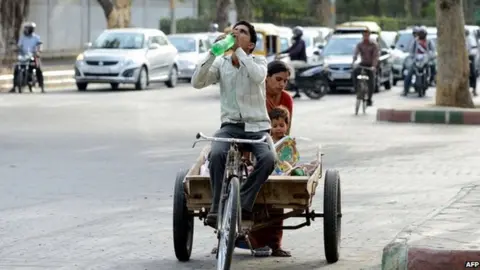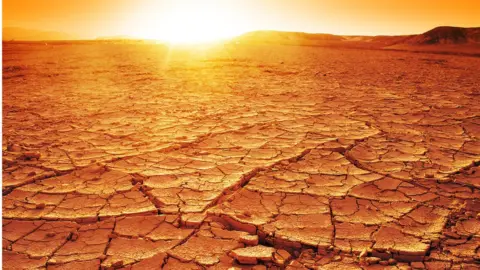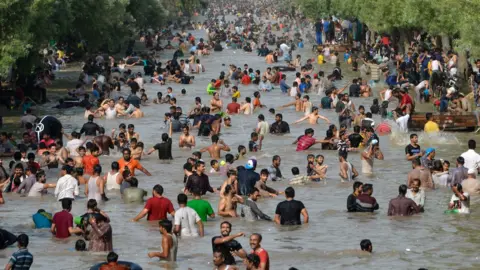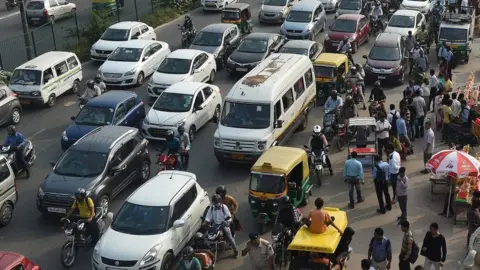Why India needs to worry about climate change
 AFP
AFPA report by the Intergovernmental Panel on Climate Change (IPCC) has warned of disastrous consequences if current trends of global warming are not reversed immediately. Aayushi Awasthy from the University of East Anglia's Energy and Resources Institute explains why this has particular consequences for India and South Asia.
The IPCC report, which was released earlier this month, has been called the most extensive warning yet on the risks of rising global temperatures.
The report says that the impact of a 1.5C increase in global temperatures will "disproportionately affect disadvantaged and vulnerable populations through food insecurity, higher food prices, income losses, lost livelihood opportunities, adverse health impacts, and population displacements".
India stands to be one of the nations most significantly affected, given its huge population and levels of inequality and poverty.
If exposed to the kind of destabilisation the report talks about, the impact on India could be devastating - not just socially but also politically.
For one, sea level rise will have a disastrous impact on the country, given its large coastline, and the number of people who live close to and depend on the sea for their livelihoods.
On the other hand, deadly heatwaves - similar to one in 2015 that killed thousands of people in India and Pakistan - could soon become the norm, with the eastern Indian city of Kolkata (Calcutta) and the southern Pakistani city of Karachi likely to be the worst affected.
And while the report says that it is not too late to reverse rising temperatures and minimise some of the harm, it will not be easy to do for countries in South Asia, which are largely developing economies with limited resources.
 Getty Images
Getty ImagesThe report estimates that investment to limit global warming between 2015 and 2050 could cost nations around $900bn (£694bn).
But this seems to be an underestimate.
When publicly outlining what post-2020 climate actions they intended to take under a new international agreement, known as Intended Nationally Determined Contributions (INDCs), many countries gave much higher cost estimates.
India said merely achieving its INDC targets would cost it $1tn, while Pakistan has estimated a cost of $40bn.
These figures give a sense of the magnitude of the problem.
It is unclear who will bear these enormous costs. The Green Climate Fund has been woefully missing its deadlines for gathering funds.
In its endorsement of the latest IPCC report, India has said it will bear a disproportionate burden of climate change.
This claim is not entirely untrue.
 Getty Images
Getty ImagesIndia is under pressure to mitigate climate change by controlling emission growth. But it will also need to adapt to increased water scarcity, droughts, floods, cyclones and other natural disasters.
The country has developed a fairly good disaster management system but it needs more resources to develop further. It has also set ambitious targets on renewable energy.
The critical question, of course, is about next steps.
The world's nations are due to meet again in Katowice, Poland to discuss the results of the report in about two months. There are a few important messages from the report that are of critical discussion especially from the point of view of South Asian countries.
The first is how the world is expected to achieve its targets.
One method outlined in the report is "overshoot", which means that countries can briefly exceed the 1.5C target and then use cutting edge technologies to remove carbon from the atmosphere so that we can eventually get back on track.
But this is a strange discussion to have, because as the report mentions with very high confidence, the technologies for large scale removal are not available at the scale required. Furthermore, this sets perverse incentives and gives countries a sense of complacency, when there is none.
 Getty Images
Getty ImagesThe second important message is that in the absence of overshoot allowances, the world needs to achieve net zero emissions by 2050.
This is important for India since it has not yet set out a target for when it will start reducing total emissions (the so-called peak emission year).
China has already named 2030 as its peak emission year.
India is currently developing a mid-century strategy for low carbon growth and the results of that study may allude to a peak year.
It has also set fairly ambitious renewable energy targets, but these come with their own set of challenges.
For instance, it would need to store renewable energy on a massive scale, but the price of battery storage has not been falling fast enough to make this a viable option.
 Getty Images
Getty ImagesThe second challenge is India's growing demand for transport. Currently the country has a very high number of bicycles and cycle rickshaws.
But as incomes increase, more and more people are starting to migrate towards vehicles like motorcycles and scooters.
To mitigate that, India needs to introduce electric vehicles and also urgently strengthen its bus, rail and public infrastructure to move towards more sustainable means of transport.
This will be a challenge because the resources that will be required in terms of technology and finance are not clear.
But what is clear, is that to dramatically reduce emissions by 2050, the solutions for these problems need to be thought about today.
And given that South Asian countries clearly lack the capacity to solve these issues on their own, international co-operation will become all the more crucial to ensure that the world does not miss its targets again.
Aayushi Awasthi is a PhD scholar (Energy Economics) at the University of East Anglia, UK
